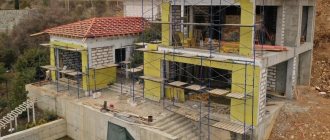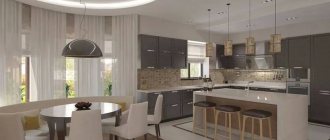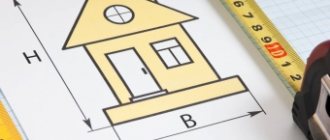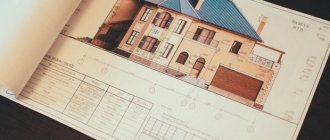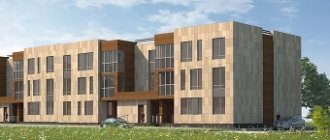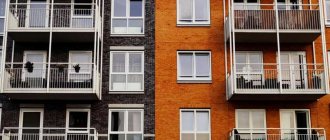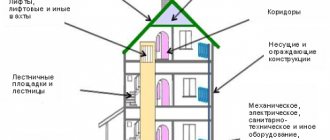Real estate
00:00, 11/23/2020 8 Plot: House in focus
What is included in the area of an individual house, how is the tax calculated and how to save on it
Photo: architekrym.ru
What is the difference between an attic and an attic, is the open terrace included in the total area of the house, why the number of storeys and the number of floors are different things, what replaced the technical data sheet and how to cheat when designing the location of the bathhouse - in the new article of the “House in Focus” project. Cadastral engineer Liliya Aleksandrovna Kupchikhina helps us figure out which elements are included in the total area of the house and which are not. Armed with this information, you can plan in advance where you will place a bathhouse or garage on the site, how you will distribute the residential floors, and whether you decide to build a separate gazebo instead of a terrace with a tea table.
Not a technical passport, but a technical plan
To register a newly built house and register ownership of it, you need to order its technical plan. In it, among other information, the area of the house will be indicated.
Until 2013, to register a house, you needed a technical passport (it was prepared by the Bureau of Technical Inventory, BTI); without it, it was impossible to register property and obtain rights to it. From January 1, 2013, a registration certificate is no longer required to register a house. Now, for the purposes of cadastral registration, a document of a different type is being prepared - a technical plan, and any cadastral engineer who, in his activities, is guided by Law No. 221-FZ “On Cadastral Activities” has the right to draw it up.
The technical passport still does not go into oblivion: for example, some banks still require its provision in order to apply for a mortgage on a house or apartment (thus throwing up the work of the BTI).
Until 2013, to register a house, you needed a technical passport (it was prepared by the Bureau of Technical Inventory, BTI). Photo yandex.ru
So, the technical plan contains information about the main characteristics of your house, including its coordinates, number of floors, and wall material. There are also floor plans. The form of the technical plan and the list of what it should contain are regulated by Order of the Ministry of Economic Development No. 953.
The area of your home, on which you will subsequently pay tax, is determined precisely in accordance with the technical plan. How it will be calculated is clearly regulated by a number of documents. Cadastral engineers, drawing up a technical plan after construction, are guided in determining the area of the house by Order of the Federal Service for State Registration, Cadastre and Cartography dated October 23, 2021 No. P 03/93 - the edition published at the link will be valid from January 1, 2021, this is the latest version these rules. In the meantime, Order No. 90 of March 1, 2016 is in effect (as amended in 2018). The differences between these two orders are insignificant and concern mainly not the measurement of the area of the house, but the calculation of errors.
What area of the building and premises is included in the real estate cadastre, the Cadastral Chamber said
The real estate cadastre (register of real estate) is an integral part of the Unified State Register of Real Estate (USRN) and is a collection of systematized information about real estate. Basic and additional information about objects is entered into the real estate cadastre. The main ones include such characteristics of an object that allow it to be defined as an individually defined thing. One of these characteristics is area. Svetlana Ulyeva, an expert at the Cadastral Chamber of the Tambov Region, told us what area of buildings and premises is included in the real estate cadastre.
Information about the area of the property is entered into the real estate cadastre on the basis of a technical plan, which is prepared by a cadastral engineer as a result of cadastral work.
The area of a real estate property (building, premises) is determined by the cadastral engineer independently in accordance with the Requirements for determining the area of a building, structure and premises, approved by Order of the Ministry of Economic Development of Russia dated March 1, 2021 No. 90.
«The methodology for determining the area in this document is applicable only for the purposes of state cadastral registration
, notes
the expert.
–
So, according to general rules, the area of a building is the sum of the areas of all floors.
In this case, the floor area is determined within the internal surfaces of the external walls. The area of a residential building includes the area of balconies, loggias, terraces and verandas. The area of a residential premises (apartment, room) consists of the sum of the areas of all parts of such a premises. It includes the area of auxiliary premises intended to satisfy citizens’ household and other needs (with the exception of balconies, loggias, verandas and terraces, used roofs) .”
In legislation there are also such concepts as “total reduced area” and “total area”. The total reduced area is used by the developer when concluding agreements for participation in shared construction to determine the subject and price of the agreement in accordance with Federal Law No. 214-FZ of December 30, 2004. It consists of the sum of the total area of the living space and the area of the loggia, veranda, balcony, terraces with reduction factors. The concept of total area is enshrined in the Housing Code of the Russian Federation. In accordance with it, the total area of both a residential building and residential premises consists of the sum of the areas of all parts of such premises, including the area of auxiliary premises intended to satisfy citizens' household and other needs related to their residence in residential premises (with the exception of balconies, loggias, verandas and terraces).
The Federal Law “On State Registration of Real Estate” does not provide for the inclusion in the Unified State Register of Information about the “total reduced area” and “total area” of a real estate property. In this regard, the areas of real estate objects that are subject to inclusion in the Unified State Register of Real Estate and are determined by the cadastral engineer during cadastral work may differ from the areas specified in the project documentation and equity participation agreements in construction. In addition, real estate cadastre records about a building and premises indicate information about the area in square meters and rounded to 0.1 square meters.
Everything inside the walls is included in the area
Generally speaking, the area of your home is measured by the exterior walls. A cadastral engineer arriving at the site measures the house from the outside using satellite geodetic measurements. Essentially, the entire outline of the building from the outside is measured - and everything inside it will be taxed. So, for example, if you plan to build a house with half-meter thick partitions between the kitchen and living room, get ready for the fact that the area measured by the cadastral engineer will not match what you measure with a tape measure inside the building.
The area of your home on which property taxes will be calculated will include the total area of all floors, including:
- thickness of walls and partitions;
- area of staircase steps and interstairwells;
- area of storage rooms, loggias, verandas, terraces, bay windows, etc.;
- area of the ground floor, basement or attic;
- the area of the bathhouse and garage in the event that, apart from the house, they cannot perform their functions (for example, they have a common wall with the house).
The area of your home on which your property taxes will be calculated will include the total area of all floors.
Photo tochmash-ural.ru Cadastral engineer Liliya Kupchikhina warns:
— Often, when preparing documents, when the final area of the house is determined, people are surprised: why did it turn out to be so much? After all, they planned it completely differently. But the fact is that in the minds of many people there are still rules from those times when the area was still divided into residential and non-residential (for example, the corridor and bathroom were considered non-residential area, and the living room and children's room were considered residential). But now, according to the law, there is no such division. The area of your home is calculated in its entirety and is determined as the sum of the floor areas. And the floor area is calculated from the outer walls from the inside along the perimeter.
It turns out that no matter how thick the walls and partitions are from the inside, all this will not reduce the area of your home in any way. An interesting nuance: compared to the previously used calculation method, the area of the house is now becoming larger. This means that citizens pay more taxes on registered real estate.
Letter of the Ministry of Economic Development dated November 25, 2019 No. D23i-40734 for the purposes of state cadastral registration and state registration of rights by virtue of Part 13 of Article 24 Federal Law of July 13, 2015 No. 218-FZ “On State Registration of Real Estate” (hereinafter referred to as the Law No. 218-FZ) the area of the building is determined in accordance with the Requirements for determining the area of a building, structure and premises, approved by Order of the Ministry of Economic Development of Russia dated March 1, 2021 No. 90 (hereinafter referred to as Requirements No. 90).
The rules for determining the area of a residential building are determined by paragraphs 2, 3, 8, 9 of Requirements No. 90. Moreover, in accordance with paragraph 8 of Requirements No. 90, the area of a residential building is determined as the sum of the areas of the floors of a residential building. The floor area of a residential building is determined within the internal surfaces of the external walls. The floor area includes the area of balconies, loggias, terraces and verandas, as well as landings and steps, taking into account their area at the level of a given floor (clause 9 of Requirements No. 90). Requirements No. 90 do not provide for the exclusion of areas from the floor area of a residential building (and, therefore, from the area of the residential building itself), with the exception of the areas specified in paragraph three of paragraph 8 of Requirements No. 90. According to clause 4.1 of the Code of Rule No. 54.13330.2016 “Residential Buildings” multi-apartment Updated version of SNi11 01/31/2003", approved by order of the Ministry of Construction of Russia dated December 3, 2016 No. 883/pr, the building may include built-in, built-in-attached, attached premises for common use, public purposes and parking, placement, technology production and operating modes of which comply with the safety requirements for residents during the operation of an apartment building and adjacent areas in the development. Taking into account the above, we note that the built-in and built-in-attached premises of a building in accordance with Requirements No. 90 should be taken into account when calculating the area of its floor and, accordingly, the area of such a building itself. When determining the area of a residential building (apartment building), regardless of whether such a building has built-in, built-in and attached premises or not, the general procedure provided for in paragraph three of paragraph 9 of Requirements No. 90 is applied. Thus, the area of multi-light premises, as well as other openings in floors, regardless of their area, are included in the area of the lower floor of a residential building. Thus: - the area of the extension premises is included in the floor area of the apartment building; - the area of the opening in the ceilings, regardless of their area, is included in the area of the lower floor of a residential building; — the area of a residential building is defined as the sum of the floor areas of a residential building. — the floor area of a residential building is determined within the internal surfaces of the external walls; — the floor area includes the area of balconies, loggias, terraces and verandas, as well as landings and steps, taking into account their area at the level of a given floor. - built-in and built-in-attached premises of a building must be taken into account when calculating the area of its floor and, accordingly, the area of such a building itself. - the area of multi-light premises, as well as other openings in ceilings, regardless of their area, are included in the area of the lower floor of a residential building.
How will the house tax be calculated depending on the area?
By the way, about taxes. In accordance with Art. 403 of the Tax Code of the Russian Federation, “the tax base for a residential building is determined as its cadastral value, reduced by the cadastral value of 50 square meters of the total area of this residential building.”
And if the owners of the house (that is, you) have three or more minor children, then another 7 square meters for each child will be “removed” from the tax base. Important: as soon as your heir turns 18, this relaxation ceases to apply to him. And if after celebrating his birthday there are only two minors left, the benefit for them is canceled too.
The tax on an already built house, registered with the cadastral register, can later be calculated using the tax calculator of the Federal Tax Service of Russia (however, you will need to prepare the cadastral number of the property in advance - it is unlikely that you will remember it by heart).
And if the owners of the house (that is, you) have three or more minor children, then another 7 square meters for each child will be “removed” from the tax base. Photo mosreg.ru
What is not included in the area of the house?
According to Order P/0393 of the Federal Service for State Registration, Cadastre and Cartography dated October 21, 2021, which will come into force on January 1, 2021, the following areas will not be included in the total area of the house:
- underground for ventilation and technical underground (the space between the foundation and floor coverings);
- unused and technical attic (the space between the ceiling of the upper floor and the roof);
- vestibule;
- porch;
- external open staircase and ramp;
- non-apartment utilities with vertical (in channels, shafts) and horizontal (in interfloor space) wiring;
- area under the heating stove (or fireplace). In this case, the stove or fireplace should not be a decorative element - they should carry a direct functional load.
For reference: a vestibule in the appendix to SNiP 2.08.01-89 is defined as a passage space between doors that serves to protect against the penetration of cold air, smoke and odors when entering a building, staircase or other premises.
Be careful: an attic and an attic are not the same thing, so when planning a house project, immediately decide whether the space between the top floor and the roof will be habitable. The attic, firstly, is considered a separate floor (do not forget that the maximum permitted number of storeys in an individual house is 3), and secondly, it is included in the total area of the residential building. The attic is not included in the area and is not used for living: many owners arrange it, for example, as a space for storing something useful or lay technological lines along it. What you choose - you need to decide before construction begins.
Liliya Kupchikhina talks about how to plan a bathhouse or garage so that they are not included in the area of the house:
— A constant question is whether a bathhouse is included in the area of the house. Yes, it turns on if the house cannot be separated from it without affecting its functionality. It also clarifies whether the garage is included in the area of the house. If, for example, a bathhouse or garage has at least one wall in common with the house and stands on the same foundation, it means that they form a single whole with the house and are included in its total area. If you don't want to include them in your taxable area, it makes sense to build them as free-standing properties with their own four walls.
Area of non-residential building
The main characteristic of a building is its area.
It is determined on the basis of full-scale measurements of such an object as the area of the simplest geometric figure, such as a rectangle, trapezoid, right triangle, or by dividing such an object into simple figures.
It is recommended to take measurements after completion of construction and finishing work.
These measurements are displayed by the cadastral engineer in technical terms in accordance with Order No. 953 of the Ministry of Economic Development of the Russian Federation.
So, how to calculate the area of a non-residential building? The area of a non-residential building or structure is correctly defined as the sum of the areas of all floors:
- aboveground;
- ground;
- underground;
- exploited roof;
- technical;
- attic;
- basement;
- other floors.
A special feature is that the area of multi-light spaces, that is, multi-light rooms, atriums, openings in ceilings, elevator and other shafts, stairs, in relation to such space is included only in the area of the lower floor of the building.
What is included in the area of a non-residential building:
- Mezzanine areas;
- Galleries;
- Balconies;
- Various halls;
- Transitions to other buildings;
- Tunnels;
- All tiers of internal shelves;
- Ramp;
- Open unheated planning elements of a non-residential building;
- The area of the roof being used;
- External galleries;
- External vestibules;
- Other similar elements.
The following are not included in the area of a non-residential building:
- An underground space intended for ventilation of a non-residential building;
- Technical underground, which does not require passages for servicing communications;
- Technical floor with a height from the floor to the bottom of protruding structures of less than 1.8 meters;
- Unused attic;
- Balconies, porticoes, porches, external open stairs and ramps that are adjacent to the outside of the building;
- Technical superstructures on the roof;
- Sites for maintenance of crane tracks, cranes, conveyors, monorails and lamps;
- Spaces between building structures that are covered with earth
Thus, the floor area of a non-residential building is determined within the internal surfaces of the external walls.
The distances used to determine the floor area are measured at a height of zero to 1.10 meters from the floor level. Skirting boards, decorative elements, cable ducts, heating or air conditioning systems are not included.
